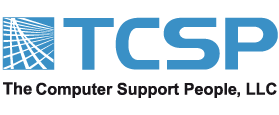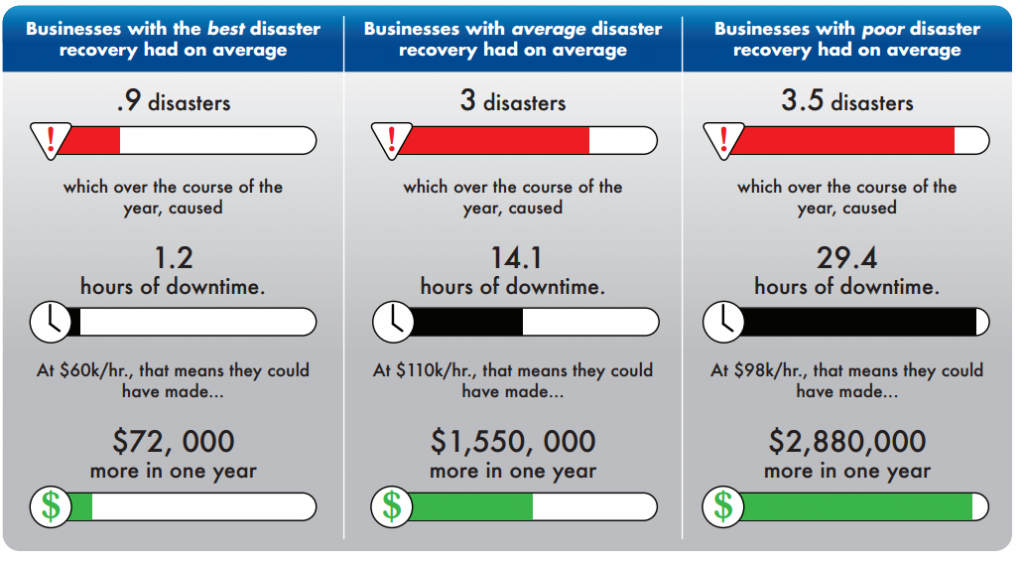Backup and Disaster Recovery
The most important resource for any business is the data that they collect and generate on a daily basis. Ensuring that this data is always accessible should be one of the highest IT priorities for any business. It is critical for any business to have a reliable data backup solution and disaster recovery plan in place.
There are many things that can cause data loss, or even complete failure of your systems. Viruses, malicious actors, natural disasters, or even the occasional power surge can render your data and computer systems useless. Without the proper protections and backup strategies in place, this can be disastrous to your business!
Causes of Failure
Apart from the obvious and occasional instance of a power outage, additional sources of data loss can also be from errors made by the company’s own staff.
Businesses reported the following disasters:
- Accidental deletion
- Virus/malware
- Application failure
Also, hardware failure due to natural disasters such as earthquake, flood, tornado, fire, lightning or power surges can instantly destroy your data and IT systems.
When building a Disaster Recovery plan, it’s important to consider all contingencies to create a truly effective solution for your business.
Planning for the Worst
If you want to backup your data and services and then be able to recover them quickly in the case of a disaster; you need to know where that data is, and the services that were used. Prioritize the data and services based on the following in decreasing order:
- How long you can go without the data/service?
- How much will it cost you, the longer the data/service is unavailable?
Finding the answers to these and other related questions is at the heart of solid backup and disaster recovery. Doing so allows you to figure out how to protect all your data and services, the most efficient order in which to restore them, and so on.
Backup Options
On-site Backups
On-site backups are generally much faster to restore and verify than cloud backups. When an entire system is compromised, an image-based backup can restore an entire server to the previous state in as little as 20 minutes. Additionally, there is the option of file-based backup, if you only need to restore an individual file or revert to a previous version of a file. Additionally, this solution is the responsibility of the business and should check backups regularly and change media as necessary.
Hardware Solutions
There are a few different backup media that a business can use:
Tape – Traditional but low reliability of tapes over time.
Removable Hard Drives – They are common and involve a set of external hard drives that are rotated daily to ensure a continuous backup stream. This requires the drives to be changed every day. If a drive is not changed, most software will skip that day’s backup. Negligence over time runs a higher risk of data loss.
Network Attached Storage (NAS) – Involves a large amount of storage in a device that attaches to your network. These are often smaller, secondary servers for your environment. Because of the larger storage volumes and the use of a system called RAID, these solutions are simpler to manage and are far more reliable for long-term backup.
Software Solutions
Just as there are several backup hardware devices, there are many software providers that will work with you to manage the backup process and the retrieval of data. We are able to install, configure, and schedule the backup system. Proper configuration is necessary to ensure that the storage is managed effectively and that there is a proper mix of file-based and full system image backups. Proper planning is needed to make sure that critical server and user data is properly protected. TCSP is constantly re-evaluating solutions on the market to ensure that you are receiving the best value, and best product for your infrastructure size and needs.
Cloud Backups
Cloud backup makes backup far simpler for small businesses. Retrieval times are often far slower, but there is less user intervention needed. The backup provider will manage the hardware and verify the integrity of the backed-up data. All the user needs to do is set the backup schedule that is convenient for them. Expanding the needed storage is also simple, these solutions are scalable as for a growing business. Cloud-based backup solutions are file-only backups. These backups take several versions of the file and can be restored to dissimilar hardware.
Virtual Environment Backups
Backup recovery of failed virtual machines is as little as 2 minutes with near-continuous data protection with built-in replication.
Organizations are modernizing their computer systems in order to provision IT services faster, strengthen security and control, and lower operational costs. While building modern data centers, organizations invest in server virtualization, modern storage applications and cloud-based services. However, businesses are facing new demands from end users including access to data and applications 24/7, no patience for downtime or data loss, and exponential data growth at 30-50% per year.
Hard Disk Recovery
Inevitably, there will be times that a drive will completely fail and the data will be unrecoverable. Traditional hard disks can suffer any number of mechanical failures, and even the newer solid state disks have an expected lifetime. Often times when we see this, it is data stored on an employee computer that is not part of the backup program, or a bring-your-own (BYO) device. Disaster recovery solutions allow a business to retrieve data previously thought to be lost forever. TCSP partners with some of the best in the industry to provide a high level of data recovery success for their clients. This process often involves the complete disassembly and destruction of the original storage media. TCSP’s data recovery partner will offer several options to recover the data.
 TCSP
TCSP



